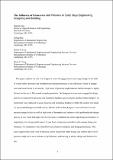| dc.contributor.author | Faas, Daniela | |
| dc.contributor.author | Bao, Qifang | |
| dc.contributor.author | Frey, Daniel | |
| dc.contributor.author | Yang, Maria | |
| dc.date.accessioned | 2014-07-08T20:00:52Z | |
| dc.date.available | 2014-07-08T20:00:52Z | |
| dc.date.issued | 2014-05 | |
| dc.date.submitted | 2013-04 | |
| dc.identifier.issn | 0890-0604 | |
| dc.identifier.issn | 1469-1760 | |
| dc.identifier.uri | http://hdl.handle.net/1721.1/88215 | |
| dc.description.abstract | This paper explores the role of a designer's sense of engagement in early stage design. In the field of virtual reality, presence and immersion are standard measures of an individual's sense of engagement and involvement in an activity. High levels of presence might indicate that the designer is highly focused on the work. The central research question is the following: do designers who are more engaged in design activity, as measured by presence and immersive tendency questionnaires, produce better designs? An experiment was conducted to assess presence and immersive tendencies within the context of a hands-on, open-ended design-and-build activity. The results indicated that the designers' sense of immersion and presence ranged widely as well as their sense of frustration and calmness while performing the design activity. It was found that higher levels of presence correlated with either high design performance or low design performance. Lower levels of presence correlated with average design performance. No correlations were found between immersive tendency and design performance. This study suggests that some level of presence can be linked with better design, and it implies that level of presence might serve as an indicator of performance and learning in similar design-and-build activities. | en_US |
| dc.description.sponsorship | National Science Foundation (U.S.) (Award CMMI-1130791) | en_US |
| dc.language.iso | en_US | |
| dc.publisher | Cambridge University Press | en_US |
| dc.relation.isversionof | http://dx.doi.org/10.1017/S0890060414000055 | en_US |
| dc.rights | Creative Commons Attribution-Noncommercial-Share Alike | en_US |
| dc.rights.uri | http://creativecommons.org/licenses/by-nc-sa/4.0/ | en_US |
| dc.source | Prof. Yang via Angie Locknar | en_US |
| dc.title | The influence of immersion and presence in early stage engineering designing and building | en_US |
| dc.type | Article | en_US |
| dc.identifier.citation | Faas, Daniela, Qifang Bao, Daniel D. Frey, and Maria C. Yang. “The Influence of Immersion and Presence in Early Stage Engineering Designing and Building.” AIEDAM 28, no. 02 (May 2014): 139–151. | en_US |
| dc.contributor.department | Massachusetts Institute of Technology. Department of Mechanical Engineering | en_US |
| dc.contributor.department | Massachusetts Institute of Technology. Engineering Systems Division | en_US |
| dc.contributor.approver | Yang, Maria | en_US |
| dc.contributor.mitauthor | Bao, Qifang | en_US |
| dc.contributor.mitauthor | Frey, Daniel | en_US |
| dc.contributor.mitauthor | Yang, Maria | en_US |
| dc.contributor.mitauthor | Faas, Daniela | en_US |
| dc.relation.journal | Artificial Intelligence for Engineering Design, Analysis and Manufacturing | en_US |
| dc.eprint.version | Author's final manuscript | en_US |
| dc.type.uri | http://purl.org/eprint/type/JournalArticle | en_US |
| eprint.status | http://purl.org/eprint/status/PeerReviewed | en_US |
| dspace.orderedauthors | Faas, Daniela; Bao, Qifang; Frey, Daniel D.; Yang, Maria C. | en_US |
| dc.identifier.orcid | https://orcid.org/0000-0002-7776-3423 | |
| dc.identifier.orcid | https://orcid.org/0000-0003-0663-8438 | |
| dc.identifier.orcid | https://orcid.org/0000-0002-9886-7512 | |
| dc.identifier.orcid | https://orcid.org/0000-0002-6720-8880 | |
| mit.license | OPEN_ACCESS_POLICY | en_US |
| mit.metadata.status | Complete | |
